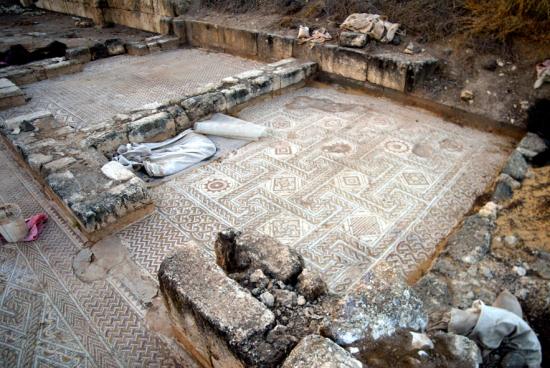Ilan Ben Zion
Source - http://www.timesofisrael.com/on-galilees-shore-israel-weighs-restoring-splendor-of-early-islam/
Parks authority assessing project to preserve ruins of a caliph’s 8th century castle, which would join just a handful of Muslim heritage sites in Israel
 Aerial photograph of the Umayyad palace at Khirbat al-Minya (photo courtesy of Minya Excavations, The Hebrew University of Jerusalem, Ilan Arad)
Aerial photograph of the Umayyad palace at Khirbat al-Minya (photo courtesy of Minya Excavations, The Hebrew University of Jerusalem, Ilan Arad)
Elegant mosaics and intricate carvings adorning the palace of one of the first caliphs could be returned to their former glory should Israel’s parks authority get behind a project to restore one of the country’s most important Islamic sites.
The Nature and Parks Authority is evaluating taking part in a project to preserve Khirbat al-Minya, the ruins of an Umayyad palace complex on the northern shore of the Sea of Galilee containing one of the oldest mosques in the country, a spokesperson told The Times of Israel. It’s one of just a handful of exclusively Islamic heritage sites run by the parks authority.
The palace was built by Walid I, an Umayyad caliph who ruled during the first half of the 8th century, and is “one of the most important Islamic sites in the country,” Dr. Gideon Avni, a specialist in early Islamic archaeology and head of the Israel Antiquities Authority’s Archaeology Division, said.
Earlier this month the Johannes Gutenberg University Mainz announced it had received €30,000 from the German government to help restore the palace, which is located on land managed by the National Parks Authority.
The parks department proposal remains in the planning and approval stages, but if it gets the green light, the NPA would match the investment with its equivalent in manpower and resources.
Tsvika Tsuk, the Nature and Parks Authority’s head of archaeology, said the project could get underway as soon as October or November.
“The site has exceptional worth, special worth, value to heritage,” Tsuk said over the phone. “Truly, this site is worthy of preservation.”
Walid was the sixth ruler of the Umayyad dynasty. He reigned in Damascus from 705 to 715 CE and extended the borders of Islam into the Iberian Peninsula and as far east as the Indus River. He’s best known for building the Great Mosque of Damascus and for completing Jerusalem’s al-Aqsa Mosque, started by his father Abd al-Malik.
The palace may have served as a summer retreat for the caliph, or more likely his son Umar, the governor of the nearby provincial capital of Tiberias.
While its mosque was plainly decorated, the palace’s gateway had more regal bearing. Majestically carved rosettes and pomegranates teased out of tawny limestone once adorned its walls along with marble paneling.
 “Colored and gilt glass mosaics decorated the summit of the dome, and stone mosaics combined with glass cubes and set in geometric carpet-like patterns on the floor of the five southern rooms indicate the official, representational character of this section,” the Encyclopedia of Islam describes in its entry on the place.
“Colored and gilt glass mosaics decorated the summit of the dome, and stone mosaics combined with glass cubes and set in geometric carpet-like patterns on the floor of the five southern rooms indicate the official, representational character of this section,” the Encyclopedia of Islam describes in its entry on the place.
Centuries later, after it fell into disuse after a major earthquake in 1068, Crusaders established a sugarcane factory on the site. One of the factory’s brick furnaces was unearthed immaculately preserved.
“It’s one of the more visually impressive sites in Israel,” Avni said. “It’s one of the few sites in Israel [from this period] which was perfectly preserved.”
Katia Cytryn-Silverman, a Hebrew University archaeologist who headed the most recent digs at Khirbat al-Minya, said the mosaics found there are unique in design and preservation but, since their discovery in 1937, have deteriorated significantly.
“Khirbat al-Minya is an important milestone in the development of this type of building,” she said.
 One of the Umayyad mosaics at Khirbat al-Minya, on the shores of the Sea of Galilee (photo courtesy of Minya Excavations, The Hebrew University of Jerusalem)
One of the Umayyad mosaics at Khirbat al-Minya, on the shores of the Sea of Galilee (photo courtesy of Minya Excavations, The Hebrew University of Jerusalem)
Avni said he hopes that the German initiative will help trigger more funding for the project. He estimated that it would require $800,000 to $1,000,000 dollars to make the site ready to be properly displayed to the public.
For the time being, however, the project aims to protect the site from the elements and will start with restoring one of its monumental archways.
Cytryn-Silverman said today the ruins are completely open to the public, and visitors habitually uncover and unwittingly damage the rare mosaics. Khirbat al-Minya also doesn’t have regular gardening maintenance, and invasive Washingtonia palms wreak havoc upon the ancient structure. The Crusader sugar factory’s furnace, beautifully preserved when it was unearthed by a German expedition in 1937, is now in a worrying state.
She emphasized the need to start preserving Khirbat al-Minya before any further damage is inflicted, voicing concern that the new initiative is already late to the game.
Her consternation was echoed by Dr. Hans-Peter Kuhnen, the German professor who spearheaded the preservation project. He said it comes “just in the nick of time – there is no more time to waste.”
“We should be sharing it with the public, it should be open, but it can only be open once there are conditions for doing so. Otherwise it’s going to get more damaged than it already is,” she said.